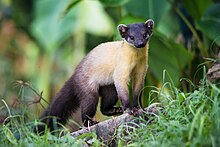Marten
| Marten Temporal range:
| |
|---|---|

| |
| European pine marten | |
| Scientific classification | |
| Kingdom: | |
| Phylum: | |
| Class: | |
| Order: | |
| Suborder: | |
| Family: | |
| Subfamily: | |
| Genus: | Martes Pinel, 1792
|

| |
Marten ranges:
| |
The martens constitute the genus Martes within the subfamily Mustelinae, in the family Mustelidae. Martens are slender, agile animals, adapted to living in taigas, and are found in coniferous and northern deciduous forests across the Northern Hemisphere. They have bushy tails, and large paws with partially retractible claws. The fur varies from yellowish to dark brown, depending on the species, and, in many cases, is valued by fur trappers.
Etymology
The Modern English "marten" comes from the Middle English "martryn", in turn borrowed from the Anglo-French "martrine" and Old French "martre" (Latin "martes"), itself from a Germanic source, cf. Old English mearþ, Old Norse mörðr, Old High German, and Yiddish מאַרדאַר mardar.
Diet
Martens are omnivorous animals related to wolverines, minks, badgers, ferrets, and weasels. Their diet consists of squirrels, mice, rabbits, birds, fish, insects, and eggs, and they will also eat fruit and nuts when these are available.[1]
Behavior
Martens are solitary animals, meeting only to breed in late spring or early summer. Litters of up to five blind and nearly hairless kits are born in early spring. They are weaned after around two months, and leave the mother to fend for themselves at about three to four months of age. Due to their habit of seeking warm and dry places and to gnaw on soft materials, martens cause damage to soft plastic and rubber parts in cars and other parked vehicles annually costing millions of euros in Central Europe alone, thus leading to the offering of marten damage insurance, "marten-proofing", and electronic repellent devices.[2][3][4][5]
Species

Recent DNA research has shown that the genus Martes is in fact polyphyletic, placing Martes pennanti and Martes americana outside the genus and allying it with Eira and Gulo, to form a new New World clade.[6] The genus first evolved up to seven million years ago during the Miocene epoch.
- American marten (Martes americana)
- Newfoundland pine marten (Martes americana atrata)
- Yellow-throated marten (Martes flavigula)
- Beech marten (Martes foina)
- Nilgiri marten (Martes gwatkinsii)
- Pine marten (Martes martes)
- Japanese marten (Martes melampus)
- Fisher (Martes pennanti)
- Sable (Martes zibellina)
Cultural references
Canada
The marten is popular in the Northern Ontario community of Big Trout Lake. During the fur trade, commissioned by the Hudson Bay Company in the 17th and 18th century, the marten pelt was typically fashioned into mittens. The marten is still traded locally. The locals place a high value on this pelt, typically trading it for chips, pop, and other consumable goods.
Croatia
In the Middle Ages, marten pelts were highly valued goods used as a form of payment in Slavonia, the Croatian Littoral, and Dalmatia. The Banovac, a coin struck and used between 1235 and 1384, included the image of marten. This is one of the reasons why the Croatian word for marten, kuna, is the name of the modern Croatian currency.[7] A marten is depicted on the obverse of the 1, 2, and 5 kuna coins, minted since 1993, and on the reverse of the 25 kuna commemorative coins.[8]
A running marten is shown on the coat of arms of Slavonia and subsequently on modern design of the Coat of arms of Croatia. Official seal of Croatian Sabor from 1497 until the late 18th century had similar design.[9][10]
Finland
The Finnish communications company Nokia derives its name, via the river Nokianvirta, from a type of marten locally known as the nokia.[11]
References
- ^ Powell, Roger (1984). Macdonald, D. (ed.). The Encyclopedia of Mammals. New York: Facts on File. pp. 118–119. ISBN 0-87196-871-1.
- ^ "Marderinfo [Information about martens]" (in German). Retrieved 15 September 2014.
- ^ "Marderschaden - Tipps gegen Marder [Marten injuries - Tips against martens]" (in German). Retrieved 15 September 2014.
- ^ "Tipps gegen Marder [Tips against martens]" (in German). Retrieved 15 September 2014.
- ^ "Marderschäden am Auto – wie ist das versichert? [Car damage caused by martens - is that a part of insurance?]" (in German). Retrieved 15 September 2014.
- ^ Flynn JJ, Finarelli JA, Zehr S, Hsu J, Nedbal MA (April 2005). "Molecular phylogeny of the carnivora (mammalia): assessing the impact of increased sampling on resolving enigmatic relationships". Syst. Biol. 54 (2): 317–37. doi:10.1080/10635150590923326. JSTOR 20061233. PMID 16012099.
{{cite journal}}: CS1 maint: multiple names: authors list (link) - ^ Croatian National Bank. First Money — History of the Croatian Currency: Kuna and lipa — the Croatian Currency. – Retrieved on 31 March 2009.
- ^ Croatian National Bank. Kuna and Lipa, Coins of Croatia: 1 Kuna Coin, 2 Kuna Coin, 5 Kuna Coin, & Commemorative 25 Kuna Coins in Circulation. – Retrieved on 31 March 2009.
- ^ Mario Jareb (2010). Hrvatski nacionalni simboli (Eng.: Croatian National Symbols). ISBN 9789532972306.
- ^ Ivan Bojničić-Kninski - Grbovnica kraljevine "Slavonije", (1895) - PDF file (in Croatian)
- ^ Story of Nokia, retrieved on the 17 July 2013
